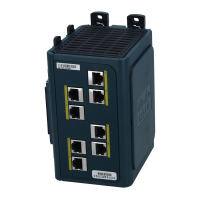24
Switch Installation
Connecting Destination Ports
Caution: To prevent electrostatic-discharge (ESD) damage, follow your normal board and component handling
procedures.
To connect to 10BASE-T, or 100BASE-T devices, follow these steps:
1. When connecting to workstations, servers, routers, and Cisco IP phones, connect a straight-through cable to an
RJ-45 connector on the front panel.
2. Connect the other end of the cable to an RJ-45 connector on the other device. The port LED turns on when both the
switch and the connected device have established a link.
The port LED is amber while Spanning Tree Protocol (STP) discovers the topology and searches for loops. This can take
up to 30 seconds, and then the port LED turns green. If the port LED does not turn on:
The device at the other end might not be turned on.
There might be a cable problem or a problem with the adapter installed in the attached device.
3. Reconfigure and reboot the connected device if necessary.
4. Repeat Steps 1 through 3 to connect each device.
Installing and Removing SFP Modules
These sections describe how to install and remove SFP modules. SFP modules are inserted into SFP module slots on the
front of the switch. These field-replaceable modules provide the uplink optical interfaces, send (TX) and receive (RX).
You can use any combination of rugged SFP modules. Each SFP module must be of the same type as the SFP module
on the other end of the cable, and the cable must not exceed the stipulated cable length for reliable communications.
For detailed instructions on installing, removing, and cabling the SFP module, see your SFP module documentation.
Warning: Do not insert and remove SFP modules while power is on; an electrical arc can occur. This could cause an
explosion in hazardous location installations. Be sure that power is removed or the area is nonhazardous before
proceeding. Statement 1087
Installing SFP Modules into SFP Module Slots
Figure 12 on page 25 shows an SFP module that has a bale-clasp latch.
Caution: We strongly recommend that you do not install or remove the SFP module with fiber-optic cables attached
to it because of the potential damage to the cables, the cable connector, or the optical interfaces in the SFP module.
Disconnect all cables before removing or installing an SFP module.
Removing and installing an SFP module can shorten its useful life. Do not remove and insert SFP modules more
often than is absolutely necessary.
